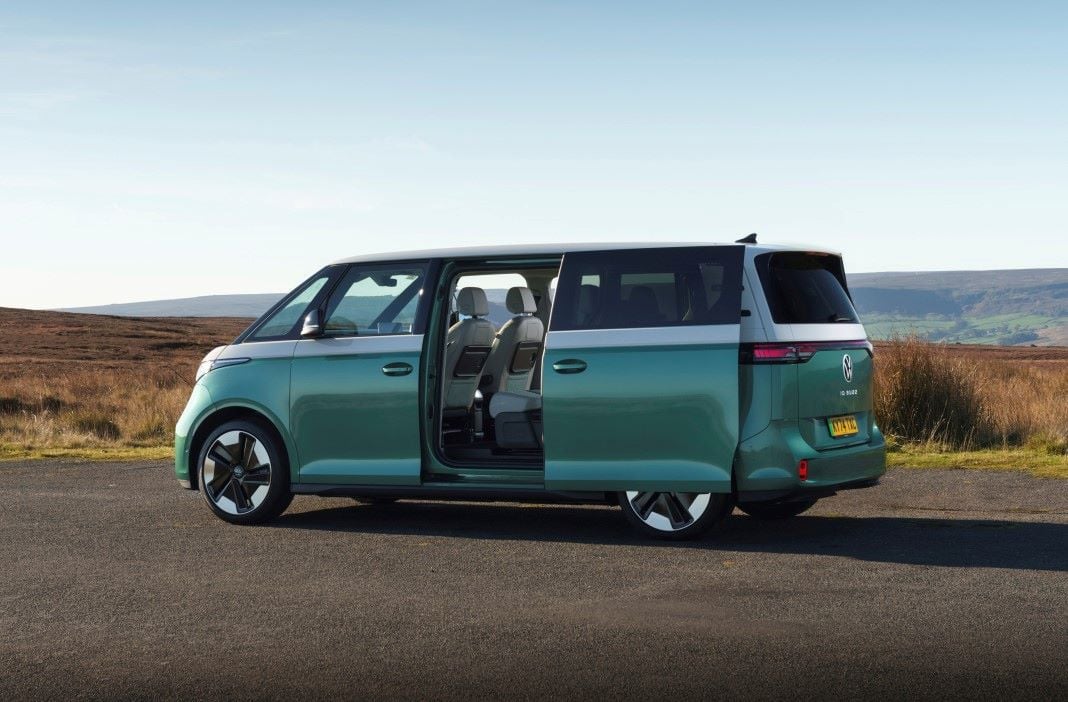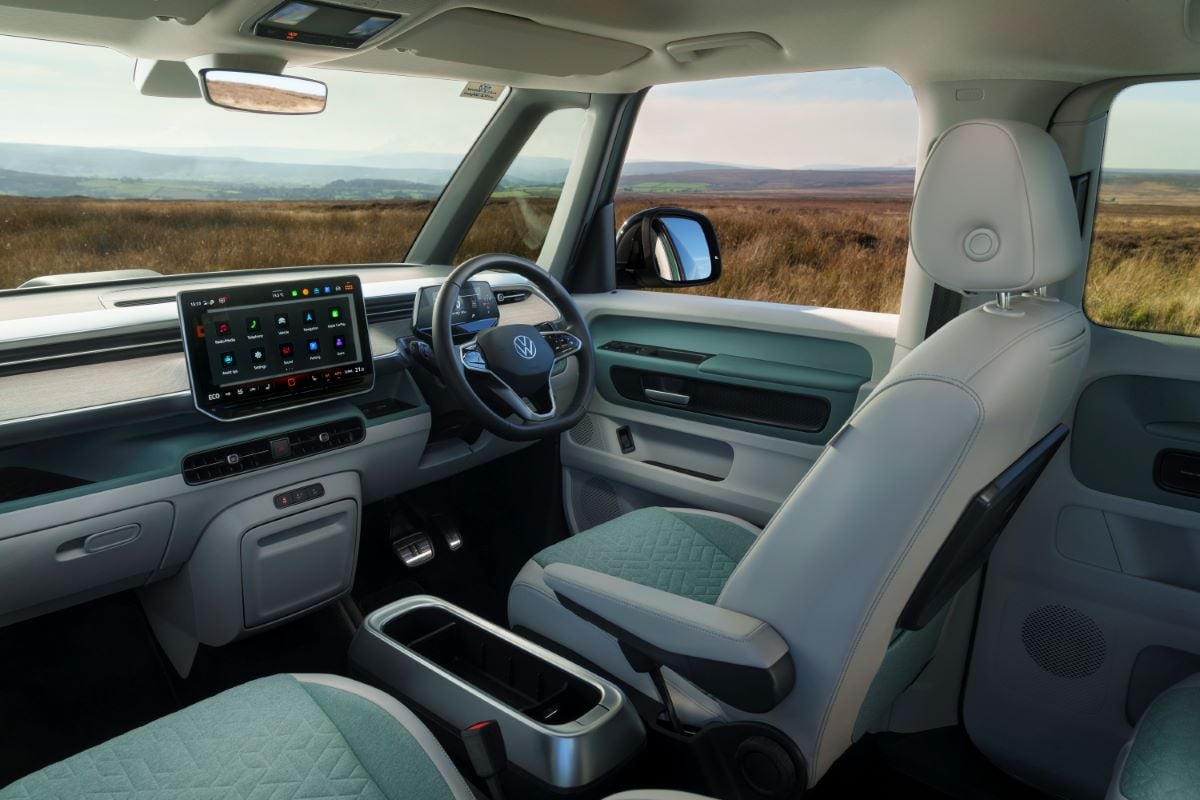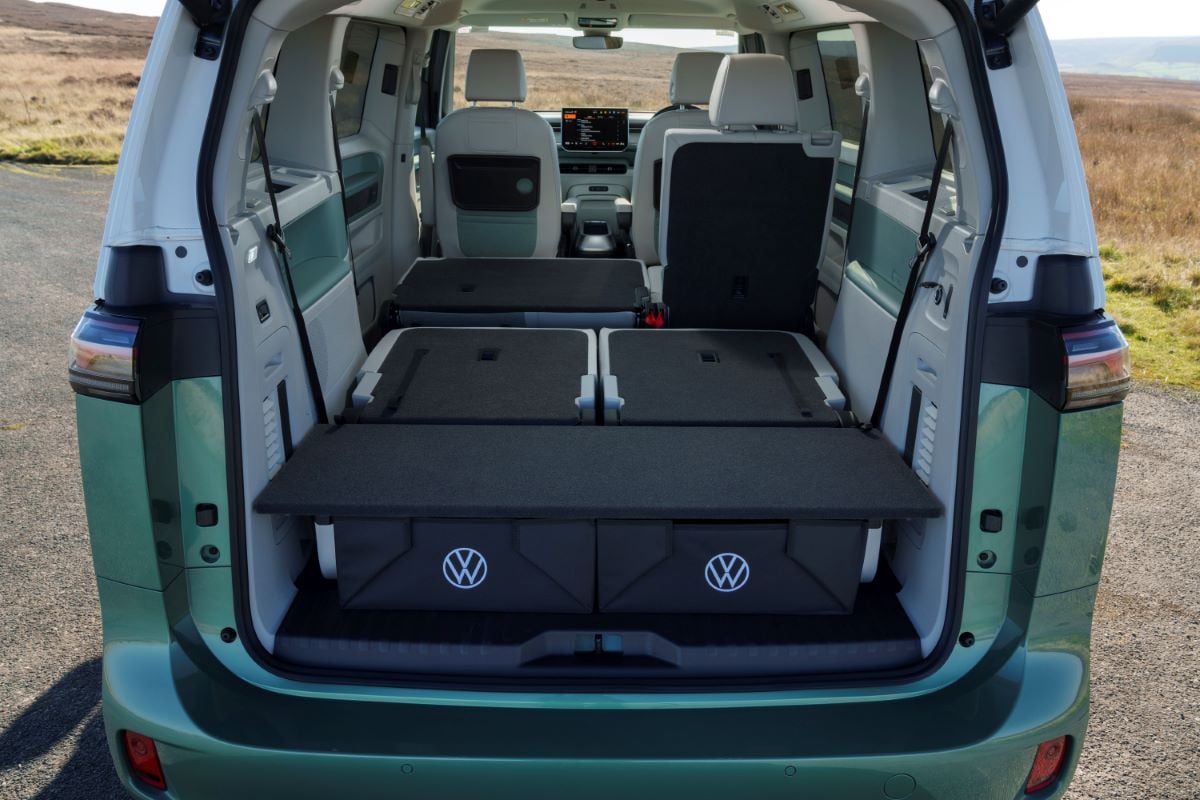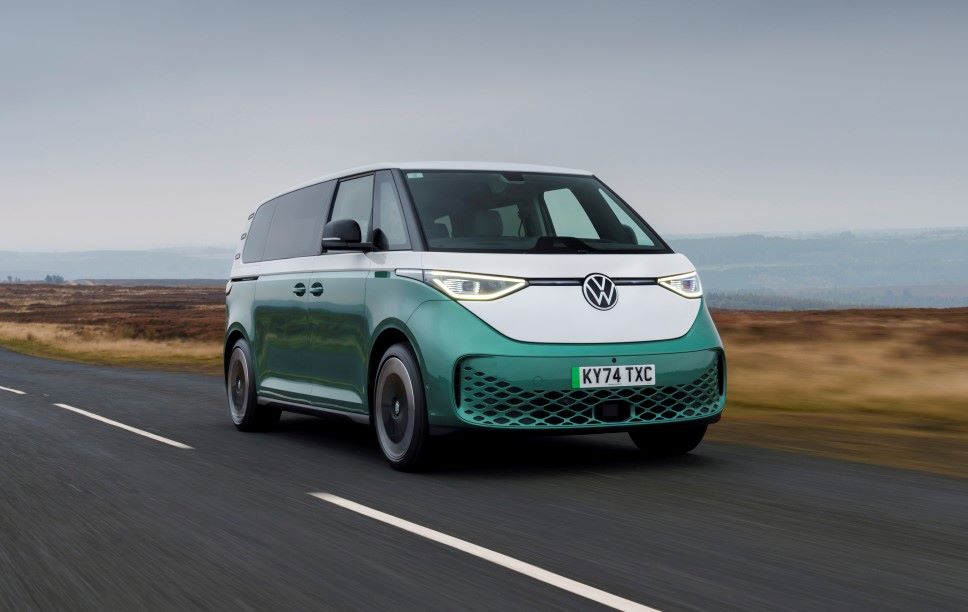
Breakdown cover from £5.29 a month for Standard cover*
• Cheaper than AA Price Promise or we’ll beat it by 20%^
• We get to most breakdowns in 60 mins or less
• Our patrols fix 4/5 breakdowns on the spot

Things you'll like
- Head-turning design
- Incredibly practical cabin
- Comfortable and effortless drive
Things to consider
- Can get expensive with options
- Fiddly touch-sensitive controls
- Huge tailgate is a pain in tight spaces
What is the Volkswagen ID.Buzz?
When Volkswagen kicked off its multi-billion Euro electric revolution with future-previewing concept cars, among the expected hatchback and SUV models was something rather special: a revival of VW’s iconic Type 2 van – also known as the Microbus.
Named the ID. Buzz, this all-electric MPV has been decades in the making with several concepts in the past, but it took VW’s flexible ‘MEB’ electric car platform to make it happen. Yes, the ID. Buzz is no van with windows despite appearances; it has the same underpinnings as the ID.3 hatch and ID.4 SUV – even though there is a van version in the ID. Buzz Cargo.
Many will be drawn to the ID. Buzz by its cool two-tone colour scheme options and retro-inspired looks. There isn’t anything else on the road that looks like it. But with the option of five, six or seven seats, plus a long-wheelbase (LWB) option, it’s also an ideal option for families – and expect an official camper version to come later.
So, is the ID. Buzz all style and space but no substance? We’ll find out in this in-depth review.
Verdict: is the Volkswagen ID.Buzz a good car?
The ID. Buzz is a refreshing alternative to big electric SUVs and converted electric vans. It might look like a commercial vehicle, but it’s impressively car-like to drive, with effortless performance, refined motorway manners and a comfortable ride.
There are more affordable alternatives, though, and ones that manage more range on a charge. But we’re very pleased the ID. Buzz exists as a true family hauler with real desirability.
Pricing, specs & rivals
Being the flagship of Volkswagen’s ID range, the ID.Buzz commands a premium for its added desirability and space.
At the time of writing (February 2025) prices start from a touch over £59,000 for the entry-level Life version in five-seat form. However, adding more seats and space doesn’t come at a premium: it’s just £150 to upgrade from five seats to six, and even more impressively only another £200 for the long wheelbase (LWB) model with its slightly bigger battery and seven seat option.
Upgrading to Style trim adds £4,800 to the base price, topping out t £64,345 for the LWB seven-seater. And topping the range is the ID.Buzz GTX, which starts from £67,435 and rising to £67,945 for the seven-seater. Of course, you can spend even more than that if you raid the options list.

Those prices seem premium until you look at what other electric seven-seaters go for. The Kia EV9, for example, starts from a little over £65,000, the Mercedes-Benz EQV is a whopping £92,000 and the Volvo EX90 is £96,000. At the other end of the scale is the Citroen e-Berlingo at just £31,000.
As for equipment, the ID.Buzz Life isn’t exactly sparse with standard kit such as heated front seats, a heated windscreen, a heated steering wheel, LED headlights, sat-nav, 19-inch alloys, adaptive cruise control and dual-zone climate control.
Upgrading to Style spec brings the all-important electrically powered side doors with opening windows, matrix LED headlights, 20-inch wheels, an electric tailgate, a head up display and a Harman Kardon sound system, as well as various style upgrades including upgraded upholstery and 30-colour ambient lighting.
Top-spec GTX trim features upgraded front seat designs with electric adjustment, red stitching and sporty detailing, a black roofliner, a panoramic glass with a dimming function, upgraded exterior styling and 21-inch wheels.
Rivals
The ID.Buzz sits in a bit of a class of its own as a style-oriented electric MPV, but there are some alternatives in different segments or price points that you might consider. Chief among those is the Kia EV9, which in lower-end trims is at a similar price point and gets close to the VW in terms of space.
If you’re willing to sacrifice on luxury, style and range than the considerably cheaper Citroen e-Berlingo (along with its Peugeot e-Rifter and Vauxhall Combo Life Electric counterparts) certainly offer lots of space and simplicity. At the other end of the scale are expensive large EVs such as the Volvo EX90 SUV and the Mercedes-Benz EQV minibus.
Volkswagen ID.Buzz: Interior comfort, quality & technology
The shape of the ID. Buzz gives clear van vibes, even though it’s car-based underneath. But that commercial vehicle influence on the outside makes a big difference to the cabin.
For starters, the lack of bonnet, large glass area and upright pillars give fantastic visibility – way better than any comparable SUV. Despite the size of even the long-wheelbase version it’s easy to park and thread through traffic – even rearward visibility is excellent, though every version gets all-round sensors and a reversing camera too.
The commanding driving position will appeal to SUV fans, too – you sit higher even than you do in a Kia EV9. There’s plenty of adjustment in the seats and steering wheel, with Style and GTX models adding handy adjustable seat-mounted armrests for extra comfort.
Quality-wise, the interior of the ID. Buzz is a step above that of ‘lesser’ ID models, with a good array of recycled soft-touch materials and a smart layout. It’s about at the same level as a Kia EV9. We also love the little van-shaped ‘easter egg’ design details dotted about inside.
However, we’d highly recommend spending a bit extra to spec one of the multiple brightly coloured seat fabric and trim packs if possible – it might not be ideal for hiding stains, but it really lifts the ambience of the cabin over the dark standard trims and plays into the car’s feel-good air. GTX trim brings darker trim, but the premium vibe means it doesn’t feel claustrophobic.
The only real complaint is the continued use of touch-sensitive controls to operate key elements of the car, such as the exterior lighting panel, mirror controls and temperature and volume sliders below the touchscreen. At least the latter elements are now backlit thanks to recent updates, but in the ID. Buzz (unlike the updated ID.3) fiddly touch-sensitive steering wheel buttons remain.

Infotainment, sat-nav, stereo and connectivity
The ID. Buzz doesn’t get the option of the giant 15-inch touchscreen available in the ID.7, but the standard 12.9-inch screen doesn’t exactly require you to squint. It’s a definite improvement over the earlier 10 or 12-inch touchscreens initially offered.
The new, larger screen is much better thanks to a crisper display, much improved responses and easier-to-use menus. You also get permanently displayed climate controls along the bottom of the screen, although the new bezel ditches the old shortcut buttons for things like drive modes and driver assists.
All versions feature integrated sat-nav with an on-board e-SIM and various connected services. Wireless Apple CarPlay and Android Auto also feature, but VW’s own sat-nav system can pre-condition the car’s battery ready for programmed-in charging stop.
As mentioned, the backlit touch sliders are more useful than before, although we’d still much prefer physical knobs and switches for the climate control and volume. We’d also still like a larger digital dial display than the 5.3-inch unit, but at least it’s there (unlike in a Tesla) and the head-up display in Style trim is handy.
We like that even the base model has a handy slot in the dash near the left stalk for wireless phone charging, but there are a total of seven USB-C sockets for passengers front and rear to charge their devices too. The standard nine-speaker audio system has acceptable sound quality, though the 700-watt 13-speaker Harman Kardon upgrade with Style spec is noticeably better.
How practical is the Volkswagen ID. Buzz?
As you’d expect from what is effectively a box on wheels, practicality is the ID. Buzz’s forte.
In terms of dimensions, it’s 4.71m long in SWB form and 4.98m long in LWB form (the latter still slightly shorter than an EV9), while at 1985mm in width it’s slightly wider than a Volvo EX90. But it’s the VW’s height of 1.93m that really makes it stand out and appear so large on the road.
Even the five or six-seat SWB model has a wheelbase (the space between the front and rear wheels) that’s nearly 3m long, while it’s 3.24m in the LWB ID. Buzz – even the Mercedes-Benz EQV can’t match that. The result is a car that maximizes internal space for its footprint on the road. It really is vast inside.
There’s oodles of space up front and an airy feel thanks to the flat floor and low centre console – no human of any size will struggle. In the rear, too, there’s tonnes of head and leg space for tall adults in both versions – no SUV gets close in that respect – and the sliding doors give easy access in and out. Three adults can sit comfortably across the second row, too.
Those doors are electrically operated on every version except base Life and are 20cm longer on LWB versions to aid access to the rear seats. The SWB version can be had in five-seat form or with six individual seats, while five, six or seven seats are available on the LWB version.
The second row of seats can recline and slide a long way back and forth to juggle boot space, or legroom in the three-row variants – and all seats are plenty roomy enough for adults. The cabin height means that, with six seats specified, you could walk through the middle of the rear seats – great for looking after children.
The only disappointment is that only two ISOFIX points are standard on the SWB model (the front passenger seat doesn’t have them), but you get another two in the rearmost seats of LWB variants to make up for that.
Storage and boot space
Oddments storage in the ID. Buzz is almost as outstanding as the passenger space. Up front, the basics are present and correct including a large glovebox and vast door bins, while you’ll also find a big shelf in the dash centre with a rubberised bottom to stop items sliding around.
Further to that, a lidded compartment below the dash opens to reveal two cupholders and further bit of storage, while even the smaller upper door pockets have USB-C ports in for charging devices. Finally, there’s the ‘Buzz Box’ – a removable centre console unit with various drawers and movable dividers that double as an ice scraper and bottle opener. It’s all very impressive.
In the rear, too, that centre console has a slide-open storage drawer, while twin pockets on each seatback combine with sturdy picnic tables. Large door bins also feature with USB-C ports.
As for seat flexibility, five or seven-seat models have a rear bench that folds in a 60/40 split via buttons in the boot, although the bench can’t be removed entirely like in some van-based models. However, six-seat versions have seats that can be individually folded and the rearmost two can be removed – the same with the seven-seater.
You’ll probably struggle to fill the boot of any ID. Buzz unless you really try. Even the SWB model has a vast 1,131 litre boot with all seats in place, but the LWB model extends this to a van-like 1340 litres in five-seat form. Fold all seats in the LWB and you’ll find nearly 2,500 litres of space -about what a typical small van offers in its load area.

It’s hard to pick fault with such a hugely practical car, but there are a couple of issues. One is the seven-seater’s boot capacity with all seats up – at 306 litres, it’s beaten by the Kia EV9. The other is the big step in the floor of entry-level Life models when the seats are folded. Higher trims feature something called a Multi-flex board – a shelf with storage boxes underneath – to create a totally flat floor, although it’s a pain to remove if you need to.
Oh, one more thing: the ID Buzz’s huge tailgate is awkward to open in tight parking spaces, requiring a lot of room. At least it’s electric on Style trim to make opening easier.
Performance & drive: What is the Volkswagen ID. Buzz like on the road?
Don’t look at the ID Buzz’s van-like dimensions and assume it’s going to be a sluggish performer – with the 2024 updates, it’s plenty fast enough for a big family hauler.
Gone is the old 204hp version, which took over ten seconds to complete the 0-62mph sprint. Now, all versions except the GTX put out a healthier 286hp, resulting in a 0-62mph time of 7.6 seconds in SWB form and 7.9 seconds in LWB form.
While faster large EVs do exist, we don’t think straight-line speed is a high priority when transporting a big family – and anyway, the ID. Buzz never feels lacking in normal driving with plenty of power in reserve for overtakes or getting up to speed.
For those wanting something that feels more Tesla-like in its acceleration, the ID. Buzz GTX’s 340hp power output and dual electric motors (giving all-wheel drive) bring the 0-62mph time down to 6.1 seconds for the SWB model and 6.4 seconds for the LWB.
On the road, all versions deliver smooth and effortless performance with an easy-to-modulate throttle pedal. The brake pedal feels predictable, too, while the VW’s regenerative braking has an adaptive mode to adjust its severity according to what’s ahead on the road.
Our only complaint is you don’t get much manual adjustment for the regen beyond the ‘B’ mode giving strong braking effect – we prefer the wheel-mounted paddles of the Kia EV9.
Power, 0-62mph times
- ID. Buzz Life and Style SWB: 286hp/ 7.6 seconds
- ID. Buzz Life and Style LWB: 286hp/ 7.9 seconds
- ID. Buzz GTX SWB: 340hp/ 6.1 seconds
- ID. Buzz GTX LWB: 240hp/ 6.4 seconds
Ride and handling
You wouldn’t expect the ID. Buzz to feel particularly sporty on the road, and even in GTX form this is a car that puts comfort over driver appeal. And we reckon it’s all the better for it.
After all, why buy a car like this if you want to be razzing it around a track or tackling twisty roads with enthusiasm? No, the big VW isn’t particularly agile, but it has plenty of grip and is excellent at providing an effortless driving experience.
Despite the car’s size, a turning circle of 11.2 metres combines with excellent visibility to make it manoeuvrable around town. The LWB version can turn in 11.8 metres, which is pretty good, but it’s not far off the length and width of a Range Rover, which counts against it when parking or on narrow roads. Still, anything with comparable space is the same.
Supple suspension means the ID. Buzz irons out potholes and craggy tarmac very well, even when specced with the largest wheel options. But it doesn’t wallow about either, avoiding making your passengers feel seasick. We reckon the VW is slightly better at keeping occupants isolated from bumps than the Kia EV9.
Noise and refinement
Being slab-sided and van-like in its dimensions, you might assume that the ID. Buzz isn’t as refined as a posh SUV, but it really isn’t far off. Some wind noise is noticeable from the large door mirrors and larger wheels promote a bit of road noise, but it’s not far off the Kia EV9 for outright refinement at motorway speeds. There’s also no fake acceleration noise, bar the usual pedestrian warning sound emitted outside.

Euro NCAP: is the Volkswagen ID. Buzz a safe car?
The ID. Buzz was crash tested by Euro NCAP back in 2022, where it received high levels of praise and the maximum five-star safety rating.
That includes an impressive 92% adult occupant protection rating, 87% child occupant rating and 90% rating for safety assists. It’s worth noting that the Kia EV9 also received five stars but can’t match the VW’s adult occupant protection score – although it’s considerably better at protecting pedestrians.
As you’d expect, all versions come with automatic emergency braking with pedestrian and cyclist detection, lane keeping assistance, a driver alert system and traffic-sign recognition, but also include a safe exit warning which stops occupants opening the door into the path of a cyclist or traffic. Blind spot monitoring has also been made standard with updates in 2024.
Further standard kit includes adaptive cruise control with stop and go tech, a 360-degree parking camera, all-round parking sensors and a Park Assist feature with a memory function.
Charging, range and running costs
When the ID. Buzz first launched at the end of 2022 it came with a 77kWh offering a merely average range of 258 miles on a charge. Happily, it’s been upgraded as part of the 2024 updates to be both more powerful and manage more distance on a charge.
Now, the cheapest versions of the ID. Buzz come with a 79kWh usable battery. While that doesn’t sound like much of an upgrade on paper, combined with a more powerful and efficient electric motor it makes the entry-level model capable of up to 283 miles on a charge in five-seat form or 277 miles with six seats in official tests.
Upgrading to the LWB model brings an even larger 86kWh battery pack, increasing the range to up to 293 miles in six-seat form and 291 miles with seven seats. That range falls by a few miles in Style trim due to larger wheel sizes and extra kit.
The ID. Buzz GTX uses the same battery packs but mated to dual electric motors for all-wheel drive. The range suffers but not by as much as you might thing, with 79kWh models offering 255 miles of range officially, and the LWB 867kWh model up to 283 miles.
These range figures compare well with the much cheaper e-Berlingo (up to 213 miles) and the much more expensive Mercedes-Benz EQV (also 213 miles). However, a Kia EV9 can manage up to 349 miles of range in its most efficient form, so the Buzz isn't among the longest range electric cars out there.
Range on a charge (WLTP figures)
- ID. Buzz Life SWB: 277-283 miles
- ID. Buzz Life LWB: 291-293 miles
- ID. Buzz Style SWB: 273-277 miles
- ID. Buzz Style LWB: 286 miles
- ID. Buzz GTX SWB: 252-255 miles
- ID. Buzz GTX LWB: 280-283 miles
With the new batteries, all versions of the ID. Buzz can now charge up more quickly too. Short-wheelbase versions 79kWh battery have a maximum charging speed of 185kWh on suitable rapid charging points, while the LWB variants can charge at up to 200kW.
That means a 10-80% top-up is possible in 26 minutes with either version. By comparison a Mercedes-Benz EQV can only accept 110kW and takes 41 minutes to do the same charge, although the Kia EV9 is even faster than the ID. Buzz when charging, lopping four minutes off the VW’s 10-80% time.
Charging speeds
(based on ID. Buzz SWB. Figures from EV Database)
- 7kW charging: 12hrs 45mins
- 11kW/22kW charging: 8hrs 30mins/ N/A
- 50kW rapid charger (10 to 80% charge): 70 mins
- 150kW+ rapid charger (10 to 80% charge): 26 mins
How much does the Volkswagen ID. Buzz cost to insure?
Insurance groups for the ID. Buzz are higher than smaller electric cars, but not excessively so. They start at group 37 for the entry-level Life Pro, rising to 40 for long-wheelbase versions, whereas Style variants are group 40 and 41 respectively. The most expensive version to insure is the GTX, sitting in group 42.
By comparison, an entry-level Kia EV9 sits at group 45 and rising to the maximum group 50 in dual-motor form, so the ID. Buzz shouldn’t break the bank in insurance terms.
Volkswagen ID.Buzz FAQs
How much does the Volkswagen ID.Buzz cost in the UK?
Prices for the ID.Buzz start from around £59,000 in the UK, with the long-wheelbase versions with the 86kWh battery only costing a few hundred pounds more. Style models start from £63,800, while top-spec GTX models are £67,400
Is the ID.Buzz a seven-seater?
Yes, Volkswagen added a long-wheelbase (LWB) version of the ID. Buzz with seven seats in late 2024. It has plenty of room for seven adults and good luggage space.
How long does it take to charge an ID. Buzz?
If you’re using the fastest available public rapid chargers it takes around 26 minutes to charge an ID. Buzz from 10-80%, whether it’s the 79kWh or 86kWh battery. A 7.4kWh home wallbox can complete a full charge from empty in 13 hours.













